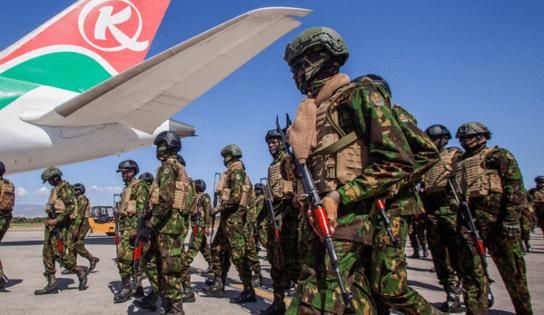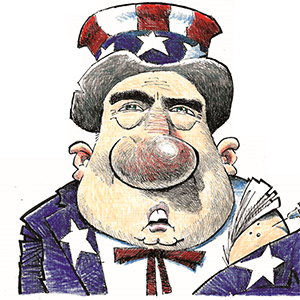Why Haiti's cities keep falling to gangs: New UN report provides disturbing insight
Published in News & Features
The upper-middle-class community of Kenscoff, which overlooks Haiti’s volatile capital, is about an hour’s drive up the hill from one of the last remaining enclaves in metropolitan Port-au-Prince that’s still relatively free from gang control.
But when a hundred armed men started killing its people on Jan. 27, under cover of darkness and after using donkeys to secretly transport their weapons into its mountaintop villages, Haiti’s security forces didn’t move in right away. The critical delay, a new United Nations report shows, was just one of many missed opportunities by the Haiti National police and the Kenyan-led Multinational Security Support mission to isolate gangs in Kenscoff and stop their deadly drive that now threatens collapse of the capital and the national government.
“There was a five-hour gap between the start of the attacks and the response of the security forces, even though the targeted areas were about an hour away from the police stations in Kenscoff and Pétion-Ville,” the U.N. Human Rights Office of the High Commissioner said about the deadly — and continuing — attacks by the powerful Viv Ansanm gang coalition.
The delay in the police response is one of the issues the U.N. highlights in what observers say is a disturbing look at why Haiti’s cities are falling to gang control. Detailing the sequence of events around the gang insurgency in Kenscoff, the U.N. report shows how the lack of strategic planning and coordination among the various police forces led to dozens of deaths before police starting arriving at 8 a.m. It also spotlights how despite sustaining significant casualties, Viv Ansanm still managed to open several battle fronts while getting a foothold in one of the capital’s strategic enclaves.
“The gangs not only have the numbers ... to be able to attack, but basically the ability to open multiple fronts simultaneously,” said Romain Le Cour, a senior expert at the Global Initiative Against Transnational Organized Crime, an organization based in Switzerland that is closely following the crisis in Haiti. “We’re not even talking about Port-au-Prince anymore; they can attack Kenscoff in the morning and be in Mirebalais in the afternoon because honestly ... the law enforcement agencies in Haiti do not have the personnel, the equipment and the ability to respond on multiple fronts.”
Over the past year, armed groups have expanded and now control up to 90% of Port-au-Prince. In the past weeks, they’ve extended their reach to the Central Plateau and have all but taken over the cities of Mirebalais and Saut d’Eau, both north of the capital.
More than 1,500 people have been killed this year in gang-related violence, the U.N. said. Amid the violent clashes, the report notes, the gangs have committed appalling human-rights abuses, raping, killing and burning victims alive.
Among the 262 killed in Kenscoff as of the end of March were 147 gang members. Another 115 were residents of the areas who were shot to death inside their homes or while fleeing. Also among the dead: four cops and a one-month-old baby, the U.N. report said. The infant was snatched from the arms of his distraught 28-year old mother by members of the Grand Ravine gang and thrown into the flames. The woman later died.
The report also notes that as of March 30, only one individual suspected of being a member of the Grand Ravine gang had been arrested. He is suspected of having facilitated the infiltration of gangs into Kenscoff.
“No action had been taken by the Port-au-Prince prosecutor’s office to investigate these attacks or identify their perpetrators,” the report said.
Under the U.N. Security Council’s mandate that authorized the deployment to Haiti of Kenyan police officers, the Haitian police are responsible for leading the law enforcement response. But the report illustrate police deficiencies and hints at internal conflicts among Haitian officials and within the command structure, raising questions about whether the U.N. mandate should change.
Earlier this year, U.N. Secretary-General António Guterres ruled out deploying a formal peackeeping force despite a request from Haiti’s nine-member Transitional Presidential Council. Instead, he recommended that the mission be modified, with the U.N. picking up some of the costs and providing logistics support. Guterres’ proposal still relies heavily on voluntary contributions, which at $110 million currently still isn’t enough to keep the Kenya mission running past September. No decision has been made by the Security Council or the Trump administration about additional money for the mission, which received more than $629 million under the Biden administration.
In the meantime, gangs continue to escalate their attacks while running roughshod around the country’s police forces.
“Right now, you don’t have the personnel, you don’t have the equipment, you don’t have the minimum level of dialogue, communication, coordination and cooperation among the forces,” Le Cour said. “You need more strategy, you need more operational planning and training. You need much more coordination and maybe a new chain of command.”
On Wednesday, Le Cour’s Global Initiative published its own report about the ongoing gang attacks. It notes that since last year’s merger of Haiti’s most powerful gangs, the Viv Ansanm coalition has gone from being “a perpetrator of violence to strategic power brokers.”
Gang control is increasingly taking hold in Haiti, the group’s Haiti Observatory said, and with each advance, gangs set up extortion checkpoints in territories under their control.
“The fact that the gangs attacked Kenscoff and a couple of weeks after that you already have checkpoints in place extracting rent, getting money, harassing the population, harassing public forces, this is very strategic, and it’s very well done,” Le Cour said.
Despite the large casualties among the ranks of gang members, they continued to field reinforcements, the U.N. report said.
“The thing is, you can kill like 25, 50, 75 gang members and the gangs have much more people to send, unfortunately,” Le Cour said.
The U.N. report shows gangs have been able to take the initiative and make decisions in a way the Haitian police and the Kenya-led force have been unable to do.
“The gangs have been setting the tempo for the past year or more,” said Le Cour. “They’ve been working and improving and they’ve been getting stronger... They’re putting their brains behind what has to be done, and unfortunately when they announce something they are going to do, they do it, which is kind of disturbing.”
The U.N. report noted that while police were deployed in Kenscoff between Feb. 5-15, gang members continued to rape and kill its residents.
Gangs resumed their attacks in Kenscoff between Feb. 16-26. One member of the Haitian military was killed along with two agents from an armed environmental agency. As gang members fled, another 18 of their members were killed by security forces and self-defense groups in the Thomassin area of Pétion-Ville.
“In retaliation, the gangs killed a woman and her child inside their home in the neighborhood of Godet, then they burned their bodies,” the U.N. said. “After a few days of relative calm, on 26 February, the gangs once again invaded the localities of Belot, Bois d’Avril, Godet, and Morne Boucan, forcing hundreds of people to flee.... At least 30 homes were ransacked and set on fire.”
The situation “remains volatile,” Kenscoff Mayor Masillon Jean said Wednesday.
Amid growing concerns that gangs will spread beyond central Haiti, officials in the mayor’s office in the northern city of Cap-Haïtien announced this week the creation of a security group to strengthen coordination between local authorities, law enforcement and community representatives throughout the port city, where most cops don’t have vehicles.
Gangs warned of attack
Highlighting the police failure to prevent the first attacks on Kenscoff, the U.N. noted that gangs had publicized their plans and both the prime minister and justice minister later acknowledged they had had intelligence reports about the coming actions.
During a press conference at police headquarters three days after the attacks, Prime Minister Alix Didier Fils-Aimé said the Superior Council of the National Police had been aware for several days of a possible gang attack in Kenscoff, the report said. The following day the new secretary of state for public security Mario Andresol, a former police chief, confirmed the prime minister’s statement.
“Although he acknowledged operational failures within the police, particularly regarding coordination, operational planning, and the overall approach to combating insecurity (Andresol) ruled out the possibility of taking administrative or disciplinary measures against the Director General of the National Police of Haiti,” the U.N. report said.
Instead, the police chief, Rameau Normil, who has publicly complained that officers do not have sufficient equipment to battle the gangs, was told to mobilize all police units.
Among its list of recommendations, the U.N. is calling on the Haiti police to develop a comprehensive plan to regain control of areas affected by gang violence and protect residents, and strengthen its intelligence-gathering capabilities.
_____
©2025 Miami Herald. Visit miamiherald.com. Distributed by Tribune Content Agency, LLC.







Comments